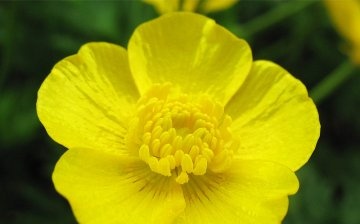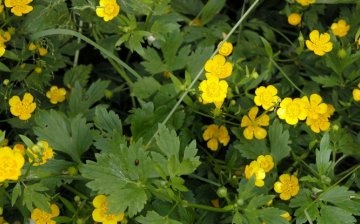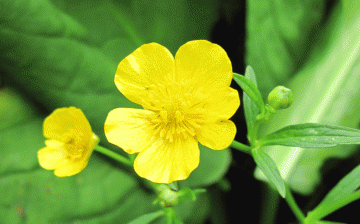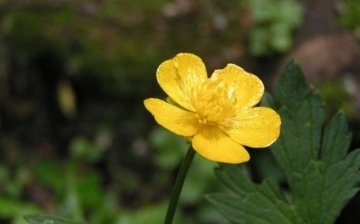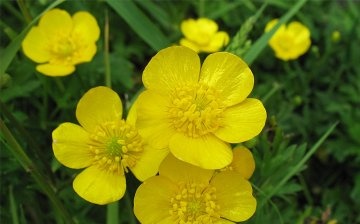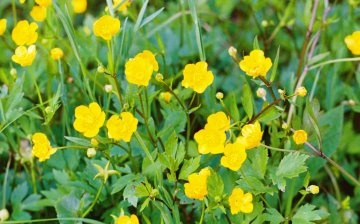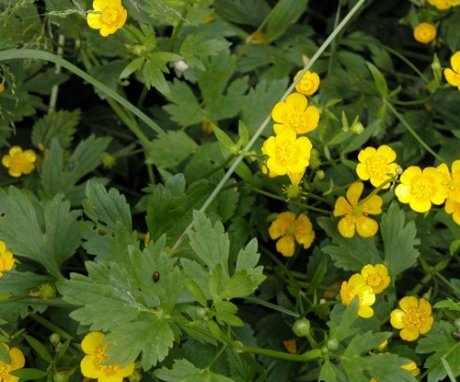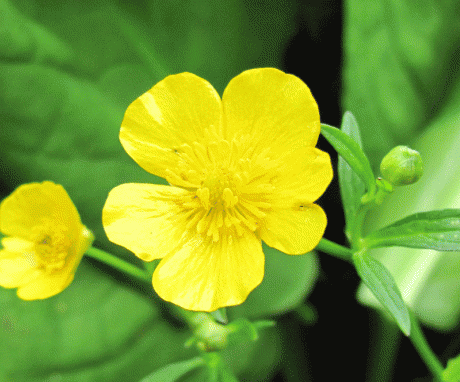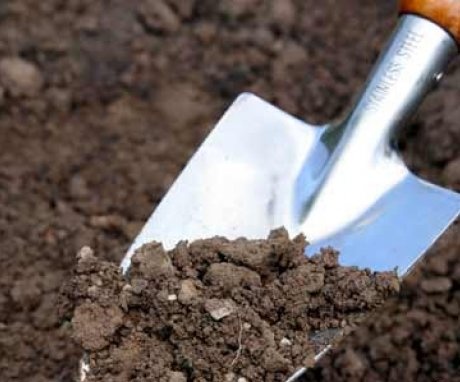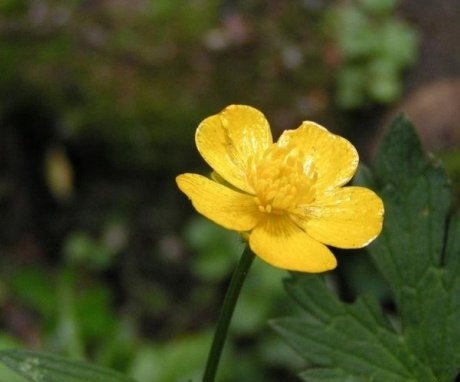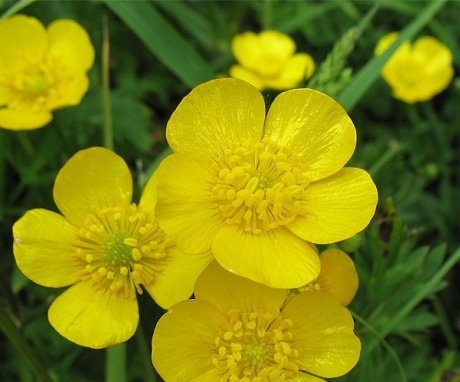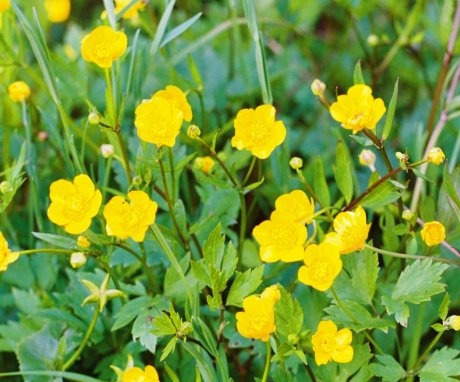Buttercup creeping - a beautiful plant with medicinal properties
Creeping buttercup - the plant is found in the wild in Asia, Europe, North-West Africa. It prefers moist, shaded, alluvial lands, it can be seen near lakes and rivers, near swamps, in bushes, in meadows and fields. It belongs to the buttercup family, which has about 600 species.
Content:
- Description of creeping buttercup
- The use of creeping buttercup in medicine
- Lighting and soil requirements
- Reproduction and planting
- Perennial care
- Diseases and pests
Description of creeping buttercup
Buttercup creeping is a perennial herb that has a height of 15-40 cm and short branched roots. The flowers have 5 sepals, 5 bright yellow petals, many pistils and stamens. The plant blooms in June. All types of buttercups are poisonous plants, so they should not be planted in a home with children.
Types of buttercups, in addition to creeping buttercup:
- Buttercup pungent. Buttercup pungent grows to a height of 30-100 cm. It has an erect stem, covered with compressed hairs and short roots, collected in a bunch. Golden flowers bloom at the ends of the branches. It is also called "night blindness", since it contains protoanemonin, it irritates the mucous membranes of the eyes (they say that chickens that eat such a buttercup become blind).
- Banewort. Burning buttercup is a plant with a small erect stem, 20-50 cm high. Below the soil, the plant has long-petiolized leaves, they are wider than the upper ones. It has small, faded yellow flowers. It grows mainly near water bodies.
- Buttercup field. Buttercup field likes swampy, loamy lands. It has deeply dissected leaves and yellow flowers. Grows in pastures.
- Poisonous buttercup. It is a one- or biennial plant with a hollow, straight and branched stem, it is 10 to 70 cm in height. It has shiny and fleshy leaves and small creamy flowers.
- Buttercup is multiflorous. It has a tall, erect and pubescent stem. Leaves have linear or wedge-shaped lobes. It blooms in early June with bright yellow flowers. Grows mainly in forests and meadows.
- Marsh buttercup. Marsh buttercup is a faded green perennial plant with a thin, bare stem and white-yellow flowers.
The use of creeping buttercup in medicine
When scrofula, rheumatism and scabies are applied to the diseased areas of the skin - tumors and abscesses creeping buttercup. Stem buttercup applied to dissolve abscesses or accelerate their maturation. For drinking, 1 teaspoon of dried leaves and flowers is brewed with a glass of boiling water, after the infusion is wrapped and insisted for 30 minutes, then filtered and drunk at 1 tbsp. spoon three times a day for headache, epilepsy.
Important! When using buttercup creeping, when applied to the skin, it cannot be used for a long time, since the plant irritates the skin, sometimes leading to tissue necrosis and ulceration.
Lighting and soil requirements
Buttercup enjoys shaded areas the most, but plants can grow in the sun as well. But it should be remembered that buttercups do not bloom in very bright light for long. Plants also do not tolerate drafts.
It is best to plant them under a tree with a wide, but not too dense crown.
Buttercups require loose and soft soil. They don't like sandy loam or loamy soil. In heavy soils, it is required to add sand and peat soil. It is necessary that the soil at watering absorbed moisture, but it did not linger in the ground.
Reproduction and planting
Buttercup seeds are sown in a container at home in February and April, or root cuttings in August and September. Adult plants are propagated by division. Seed propagation is rarely used, since seeds germinate very poorly.
Correct reproduction of creeping buttercup by seeds:
- Sow the seeds in a container in late winter and early March.
- The seeds are covered with grooves, and then covered with earth with a layer of 2 cm.
- The temperature of the room at this time they need a low + 10-15 ° C.
- Containers with seedlings are covered with foil.
- After 2-3 weeks, the containers are placed in a warmer room with a temperature of +20 ° C.
The seedlings grown in the house are placed in the ground in the spring, when the soil warms up by 6-8 cm, since buttercups prefer to grow warm. This can be done in late April or early May. If there is a risk of frost, then cover the planting from above with straw. For planting, dig holes with a depth of 5 cm. The distance between the holes is 10 cm. Drainage from gravel is placed in them. After that, sprouts grown from seeds are planted.
Planting tubers:
- Before planting, the tubers are placed in water at room temperature for 10 hours.
- Swollen tubers are planted in a hole 5 cm deep.
- The tubers must be placed with their legs down, otherwise they will not sprout.
- After planting, it is advised to water the soil with a little water.
When planting tubers, seedlings will appear in 1.5-2 weeks. The larger the tuber you plant, the more flowers will bloom on that plant. Flowers will bloom in 2.5 months. And by the end of August, fruits ripen - multi-roots, one multi-root contains 500 small seeds.
Perennial care
Buttercup is easy to care for, even beginners can grow it:
- Watering... Watering is necessary intensively and regularly, but without overflowing the plants, as their roots can rot. If you still watered with too much water, then immediately dig up the buttercups, rinse the roots, treat with a solution of potassium permanganate and leave for 2-3 hours to dry the roots. Then plant it back in the ground. Plants also do not tolerate drought, their rhizomes dry and die off.
- Transfer... Buttercups grow and reproduce very quickly. During the season, annual plants grow up to 3 "babies", and in plants that are more years old - up to 7. Dig up the roots, detach the "children" from them and plant them in another place.
- Top dressing... When the plant grows and forms, nitrogen fertilizers are added. You can buy fertilizer "Kemira Suite"and gradually add it to the soil every 2 weeks. When feeding, buttercups bloom profusely and develop well. When flowering, add phosphorus and potassium.
- Preparing for winter... From the beginning of autumn, buttercups stop blooming, their leaves turn yellow, at this time, stop watering the plants. Then dig up the tubers, dry them and clean off the ground. Remember that this is done carefully and carefully, as the roots of plants are fragile. Then separate the kids. Process tubers and babies fungicide... Put the tubers in polyethylene bags, cover with sand or peat soil and place until spring in a cool room with an air temperature of + 5-10 ° C. Or just put in a box and sprinkle with peat. You can put boxes in your basement or cellar. Inspect the tubers from time to time to detect any diseases. If diseases are found, treat the diseased areas with brilliant green or colloidal sulfur. If almost the entire root is sick, then destroy it, and pour new peat or sand into the boxes.
Diseases and pests
Buttercups can be damaged by various diseases and pests:
- Blackleg. With it, white spots are visible at the bottom of the stem of young seedlings, which then turn brown and the plants die.
- Root rot.With this disease, the plants grow slowly, then turn yellow, and then die. Buttercups should not be planted in the ground with fresh manure so that they do not get sick with root rot.
- Fusarium wilting. In case of illness, brown spots are visible on the leaves and stems. The plant develops more slowly, and then dies.
- Powdery mildew. With a disease, a powdery coating is visible on the leaves and petioles, and then black dots appear.
- Peronosporosis. In case of illness, the plants stagnate, spots appear on the leaves.
- Rust. With her, fistulas form on the leaves, when they crack, then a rust-colored powder begins to pour out of them.
-
Nematodes... These are tiny worms that grow and develop when there is excess moisture. A plant affected by nematodes may die.
Nematofagin BT is well suited for the destruction of nematodes. It is introduced into the soil to a depth of 15–20 cm before planting the seedlings, and if the plant has already been planted, then holes are made and the substance is introduced into them. The drug is safe for animals, humans and beneficial insects.
For all these diseases, biological fungicides are used: Baktofit, Fitop, Barrier, Fitosporin, Planzir, Zaslon, Integral, Agate, Trichodermin. They have a good effect on fungal diseases and have low toxicity.
Buttercup quite unpretentious when growing.
Even a beginner can grow it. The most important thing is to plant it in the right place and water it correctly, as it does not like droughts and overflows.
More information can be found in the video:



